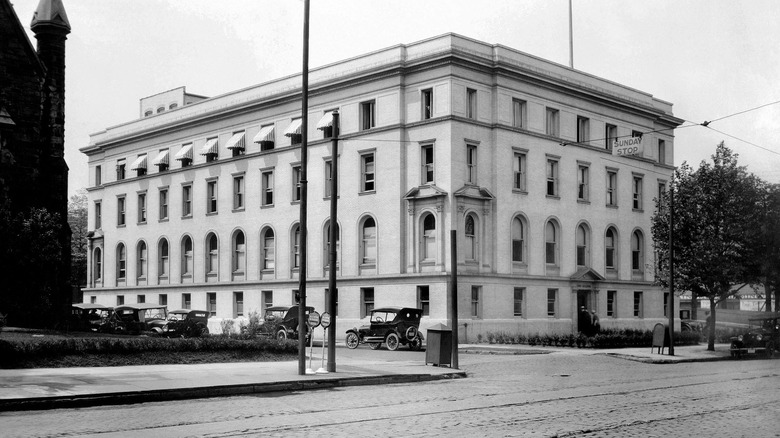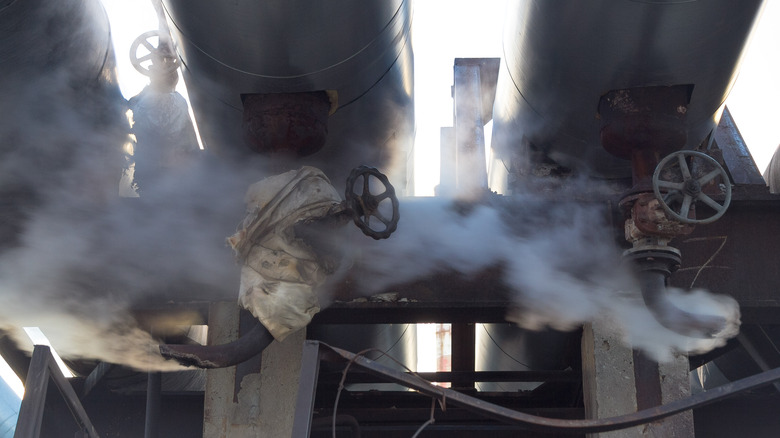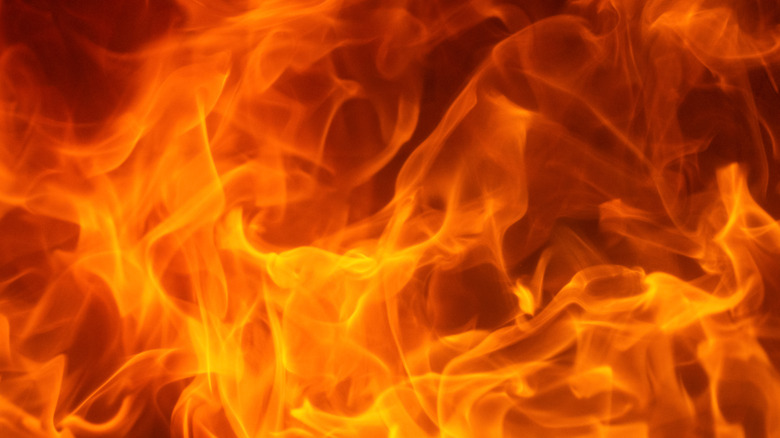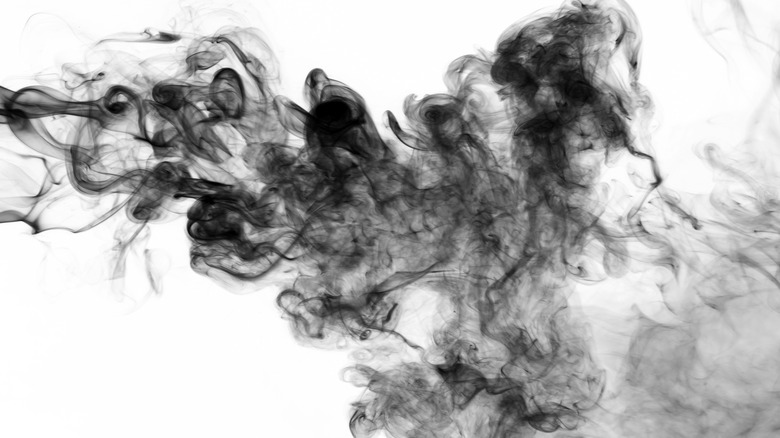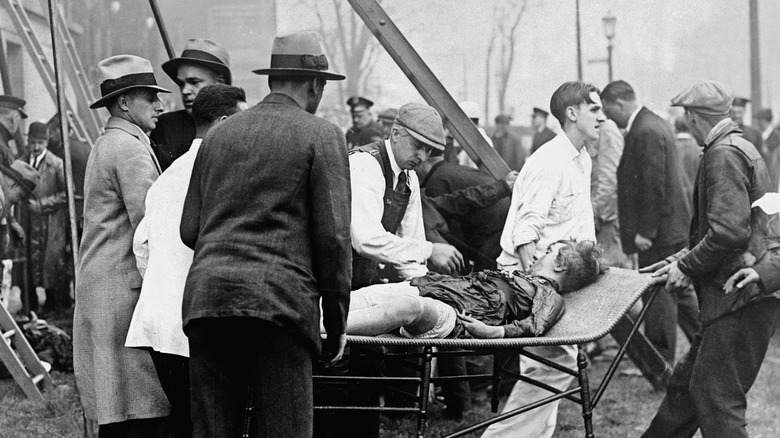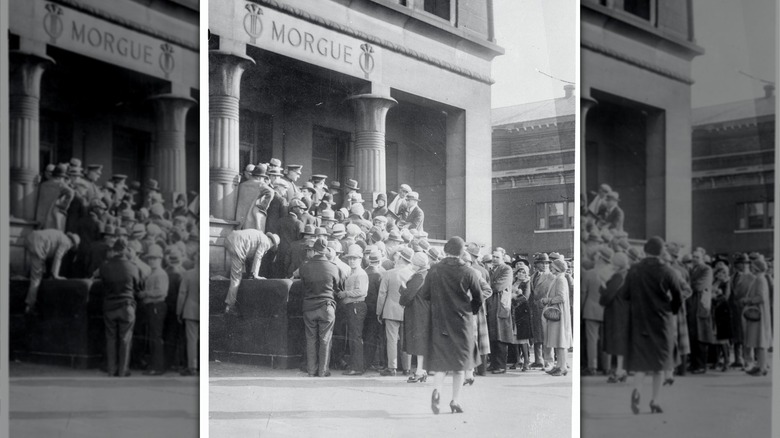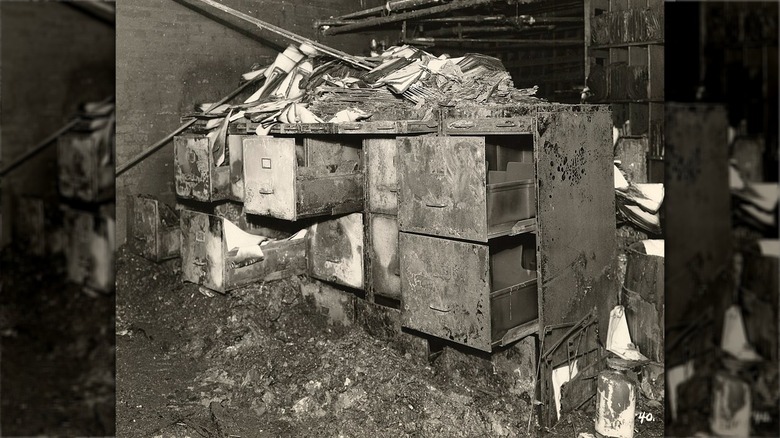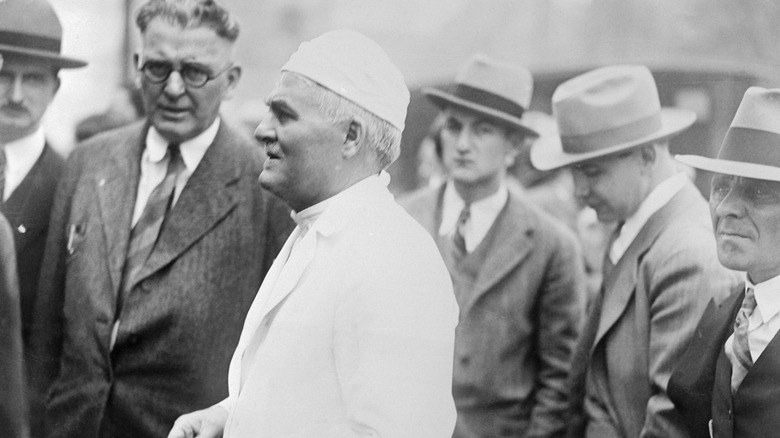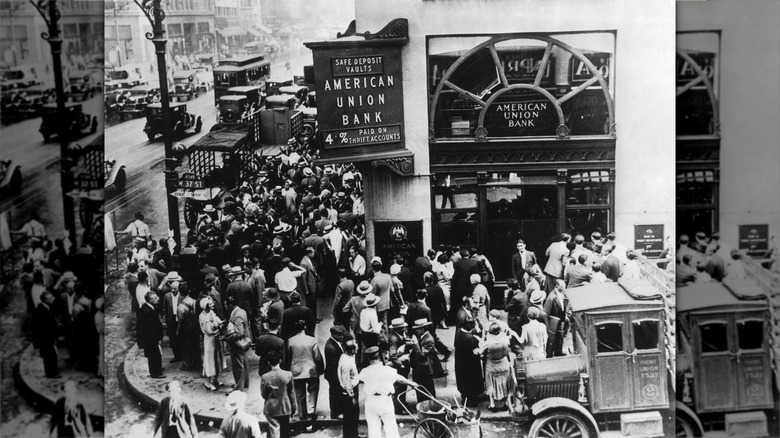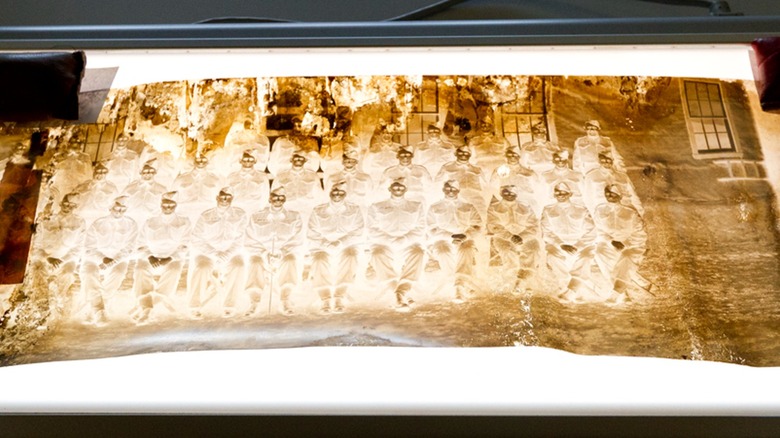The Tragic Cleveland Clinic X-Ray Fire Of 1929
If you lived in Cleveland, Ohio, back in the 1920s, there's a good chance you'd heard of the Cleveland Clinic, especially if you knew a thing or two about the medical field at the time. The idea behind the clinic first came about during World War 1, and it didn't take long for that idea to become a reality, with Cleveland Clinic opening its doors in 1921.
At the time, the technology at the clinic was cutting edge, focused on furthering research and improving medical treatment, without ever overlooking care for the patients. And if you want proof that the clinic was both well known and highly regarded, then you only need to look at their list of visitors, which includes newspaper giant William Randolph Hearst as well as foreign government officials. All seemed well.
But after less than a decade, the clinic's luck turned abruptly, and it became famous for a reason entirely separate from medical advancement and stellar care for its patients. In the summer of 1929, a seemingly random maintenance issue coincided with — or, perhaps, caused — a tragedy that claimed the lives of over 100 people. The disaster came to be known as the Cleveland Clinic X-ray Fire, though flames were hardly the only deadly factor at play.
While the Cleveland Clinic is still open and flourishing to this day, 1929 was undeniably a dark and scary year.
[Featured image by ClevelandClinicES via Wikimedia Commons | Cropped and scaled | CC BY 4.0]
It all started with a leaking steam pipe
Per the National Board of Fire Underwriters and the Ohio Inspection Bureau, the basement of the Cleveland Clinic housed a bunch of steam pipes lining the ceiling, as well as tens of thousands of sheets of X-ray film — estimates go as high as 10,000 pounds of film, kept in about 4,000 envelopes, stacked up in the unventilated room. Around 9 a.m. on May 15, 1929, clinic staff noticed a leak in one of the steam pipes, and a workman was called in to fix the problem. The workman arrived and went about doing his job, turning off the steam flowing into the broken line before leaving for about an hour, as the pipe would've been too hot to fix at that moment.
But he was greeted by a very different sight when he came back around 11 a.m. — a cloud of threatening brown and yellow gas floating near the ceiling of the basement. He tried to fix the problem himself, only to briefly pass out from the noxious fumes all around him. Fortunately, he woke up shortly after and was forced from the room by volatile, exploding gas. He escaped with a nearby maintenance man, and the two began to warn the rest of the building of what was happening. But that was only the beginning of the terrors to come.
People were trapped by the fumes and fire
The presence of noxious, yellow-brown fumes in the clinic's basement would've been bad even if the gas had been contained there. But things were only going to get worse, as there were pipes that ran up from the basement through the rest of the building.
That initial explosion didn't only knock the workman out of the room, but it also forced the toxic gas into the pipes and through the ventilation system of the rest of the clinic. The fumes spewed out into the main areas of the clinic, across multiple floors and stairwells, and it's believed that many of the victims were killed almost instantly from breathing in the gas. To make things worse, the electricity to one of the elevators shut off amidst the chaos, trapping and killing the people inside, according to survivor Dr. E. Perry McCullagh (via John D. Clough's "To Act as a Unit")
But the elevator wasn't the only thing stopping people from escaping. Upon coming into contact with the air, the highly volatile and flammable gas spontaneously ignited, starting a fire in the building which completely cut off the other elevator in the building as well as one of the stairwells (via the National Board of Fire Underwriters and the Ohio Inspection Bureau). Many people rushed toward the first floor, only to be met by a crowd telling them to turn around, as the exit was already blocked by flames.
Survivors found fresh air
As fumes and flames raged inside the clinic's walls, people rushed to find a way to escape — or, at the very least, a way to survive. According to an account left by survivor Dr. E. Perry McCullagh (via John D. Clough's "To Act as a Unit"), the fumes filled the building within the space of a minute. He found himself choking on those fumes as he staggered down the halls, where he was eventually hauled into an adjoining room, his head shoved toward an open window.
But not all of the clinic's windows were made equal, so to speak. McCullagh explained that those who found their way to the west side of the building were better off because of the way the wind happened to be blowing. In contrast, the eastern windows — where McCullagh was — actually served as the main vents for the fumes. In other words, McCullagh found himself still breathing in plenty of fumes, despite standing by a window.
Still, the wind turned out to be a strange blessing in disguise. When the fume caused yet another explosion, it blew out the roof and skylight, per the National Board of Fire Underwriters and the Ohio Inspection Bureau. The hole in the roof actually acted as an effective vent for a bunch of that poisonous smoke, clearing some of it out of the building.
The effects of the fire and gas were horrible
Though this event is widely known as the Cleveland Clinic X-ray Fire, the more you read about it, the less you hear about the actual fire. Really, the National Fire Protection Association (via Cleveland Clinic Magazine) described the tragedy best: "The most diabolical cunning could scarcely have devised an arrangement more surely calculated to spread death throughout the building," a report stated. In other words, the fire played its part in keeping people trapped, but really, it was the gas that spread the most death. It even turned the bodies of the victims a sickly yellow — then green — color.
Still, the outer appearance of the bodies wasn't all that was horrific compared to some of the things the clinic's doctors had seen in World War I. Dr. George W. Crile (and other doctors on site) had experience treating injuries received on the front — more specifically, they'd seen the effects of toxic gas on the human body. Crile found himself thinking of phosgene at that moment, as victims of the disaster were portraying the same symptoms as patients he'd treated during the war.
None of that is to say that there wasn't other damage, caused by the fire rather than the fumes. Photos published by Scene depict the aftermath of the disaster: walls (especially in the basement) scorched and blackened by the flames, ceilings flaking and caving in, and the skeletal remains of the roof.
The tragedy didn't end with the fire
Alarms were blaring by 11:30 a.m. (via the National Board of Fire Underwriters and the Ohio Inspection Bureau), and emergency personnel were quick to flock to the scene. Ladders were raised toward the people crowding the windows, people in critical condition were airlifted through the destroyed skylight, and firefighters worked to contain the flames. All told, the immediate disaster was handled by 1:15 p.m.
But just because people were able to escape from the building didn't mean that they weren't affected by breathing in those toxic fumes. Many were having trouble catching their breath, and their symptoms grew worse as the hours and days passed. Included in the list of those who died later that day was Dr. John Phillips, one of the founders of the clinic. Even for those who managed to survive those first days, the following weeks were far from easy.
E. Perry McCullagh recounted his experience (via John D. Clough's "To Act as a Unit"), which involved a six-week stint in a hospital after the fire. He and another doctor, Conrad Gilkison, had even begun to accept the idea that they would die, trading morbid quips and watching their nail beds turn blue — a sign of death for most other people.
Both McCullagh and Gilkison were fortunate enough to fully recover, but the same couldn't be said for everyone. Of the 225 people in the clinic, 123 died and about 50 were hospitalized.
The dangers of X-ray film
At the very center of the tragedy of the Cleveland Clinic fire lies the culprit behind it all: nitrocellulose X-ray film.
According to a paper published in Materials, while nitrocellulose has historically been used to make various kinds of films, it's also been a major ingredient in a far less innocent product: explosives. When heat gets involved, nitrocellulose is unstable (to put it lightly), so maybe that should have been something of a red flag. Not only is nitrocellulose explosive, but when it decomposes, the products are pretty nasty.
The National Board of Fire Underwriters and the Ohio Inspection Bureau explained that it's impossible to know exactly what was present in that yellow-brown smoke, but nitrocellulose itself can give off carbon monoxide and carbon dioxide, both of which are toxic. And that's just the beginning. There could have been some hydrogen gas in there, which is notoriously flammable, as well as nitrogen peroxide — toxic and corrosive in small amounts in the air, and capable of forming nitric and nitrous acid when mixed with water.
While those safety concerns weren't codified, a discerning eye could have put together the risks. After all, only a year before, in 1928, the same film was responsible for a deadly fire in Albany, New York (via John D. Clough's "To Act as a Unit"). Maybe someone could have seen the tragedy coming.
[Featured image by ClevelandClinicES via Wikimedia Commons | Scaled and mirrored | CC BY 4.0]
What caused the accident?
Most people would agree that the cause of the leaking, toxic gas was the thousands of sheets of nitrocellulose X-ray films stored in the basement of the Cleveland Clinic. However, the exact details of just what caused those films to degrade are a matter of debate.
There are three main theories. The report from the National Board of Fire Underwriters and the Ohio Inspection Bureau explains that some people think the heat was supplied by the leaking steam pipe that started off this entire story. The steam flowing into that room would've been well above the temperature needed to start decomposing the film, so it seems like a pretty clear-cut cause.
Others have posited that the entire tragedy was the result of negligence: a clinic employee heading downstairs to smoke a cigarette and dropping it on the floor. It's definitely a possibility, though it should be noted that the clinic's safety standards explicitly prohibited smoking in the basement.
The most widely accepted theory, though, has to do with the pendant lamps that were being used to light the room, which was already something of a hazard with the films being stored nearby. To make things worse, these lamps didn't actually provide much light, so the safety situation was potentially worsened when a clinic employee brought down an extra lamp and an extension cord. The exposed bulb would have provided the heat needed to start breaking down the film — or even setting it on fire.
Plans to rebuild
The Cleveland Clinic fire was a massive tragedy, killing hundreds of people and damaging the building in ways some believed were beyond repair. But, in the end, the clinic did manage to survive. Dr. George W. Crile, one of the clinic's founders, was actually optimistic, even while those around him feared that no one would ever want to set foot in the clinic again. "They'll talk for a while ... and then, when they forget it, we'll start using the building again," Crile said (via John D. Clough's "To Act as a Unit").
Surprising though it may seem, he was right about that. Over the next few days, clinic staff moved salvaged equipment to a nearby building that had opened its doors to their cause, allowing them to set up shop and continue to help patients. Five days after the fire, the makeshift clinic was up and running. But that didn't stop Crile and fellow founder Dr. William E. Lower from planning for the future.
The two had grand plans of rebuilding the clinic and also attaching an entirely new building (with space to further expand). That goal didn't seem out of reach; the clinic had done well financially in the years prior, after all. What's more, donations to the tune of $30,000 flooded in from as nearby as Cleveland and as far away as China and Australia. The clinic's leadership was confident in the future, and they ultimately returned all of those donations, oftentimes with interest.
The financials weren't always easy
Immediately after the fire, founders George W. Crile and William E. Lower seemed confident about what was to come and, at least on the surface, the financials appeared to support their optimism. According to John D. Clough's "To Act as a Unit," Crile criticized the government's low insurance payout, calling it nothing more than a "cold comfort" — so the clinic and its staff decided to actively do something about that. For the next year, they financially supported the families of deceased clinic members, paying them at least partial salaries in the wake of the tragedy.
But things weren't all smooth sailing. There were the legalities to take care of — more specifically, the $3 million in lawsuits that the clinic faced, which were eventually settled out of court for $45,000 instead. Crile and Lower also had to make considerable personal sacrifices, putting up their own life insurance policies for the bank loans they needed to rebuild.
Then, there's one other factor to consider: 1929 was more than the year of the Cleveland Clinic fire, it was also the year of the stock market crash. Crile himself noted how the effects of the Great Depression hit the clinic hard during the early 1930s. Banks were failing, and the clinic's staff had to take increasingly large pay cuts as time passed. Nevertheless, the staff remained loyal to their duties and grateful to have a job at all, ultimately weathering the storm.
The Cleveland Clinic fire changed safety standards
Maybe it shouldn't come as too much of a surprise that a major disaster striking a well-known clinic would bring about some level of change. And when you consider the fact that the material that caused it all, nitrocellulose, has some pretty volatile properties, it makes even more sense that something would be done.
Changes mostly came in two different categories. The most obvious change had to do with hazardous materials like nitrocellulose. In general, nitrocellulose films were phased out of regular use and replaced with new materials that posed fewer hazards. Current X-ray films often use silver bromide crystals, which are more stable when stored and considerably less flammable. And while there were some standards at the time when it came to the storage of potentially hazardous materials, those regulations were made stricter.
That second change was a slight departure from hazardous materials, instead focusing on first responders. During the fire, some of the firefighters at the scene tried to make use of an oxygen helmet — a smart move, given all the toxic fumes, but one that was ultimately abandoned because they couldn't manage to adjust it correctly (via the National Board of Fire Underwriters and the Ohio Inspection Bureau). It's hard to argue that equipment like that wouldn't have been helpful, so in the aftermath of the fire, gas masks became standard equipment for all firefighters.
[Featured image by Library and Archives Canada via Wikimedia Commons | Cropped and scaled | CC BY 2.0]
